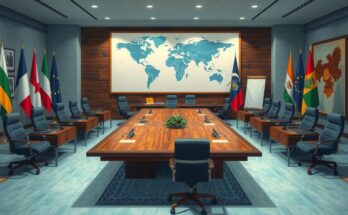In a time rife with geopolitical tension, Laos, the current chair of ASEAN, faces the daunting challenge of ensuring the bloc’s unity. The recent 57th ASEAN Foreign Ministers’ Meeting in Vientiane saw over 15 ministerial gatherings with major global powers, highlighting ASEAN’s struggle against rising instability in Myanmar and the South China Sea. Unlike its previous chairmanships, the stakes are higher, with Laos navigating a landscape beset by discord among its members.
Concerns about ASEAN’s effectiveness have surged, as revealed by the State of Southeast Asia 2024 Survey, which found that many perceive the organization as increasingly disunited. This fragmentation particularly affects discussions on pressing issues like the South China Sea dispute and the wars in Ukraine and Gaza, risking ASEAN’s standing in an evolving global order.
The contentious drafting of the Joint Communiqué following the foreign ministers’ meeting, delayed by internal disagreements, emphasized the divisions within ASEAN. The Philippines, amidst escalating tensions with China, sought to address an incident involving the Chinese Coast Guard but met with opposition from Cambodia and Laos, further straining relations.
The emergence of the SQUAD, comprising the US, Japan, Australia, and the Philippines, signifies a growing perception that ASEAN is failing to confront China’s assertiveness effectively. Although guidelines for a Code of Conduct in the South China Sea have been adopted, internal rifts could weaken ASEAN’s position, emphasizing the need for claimant states to cooperate closely to safeguard maritime interests.
The deeper rift within ASEAN regarding the conflict in Gaza illustrates how domestic and religious sentiments complicate consensus-building. Yet, despite political intricacies, the Joint Communiqué managed to include substantial discourse on this topic, hinting that collaboration is possible when members respect differing viewpoints.
The situation in Ukraine remains less urgent for ASEAN, given geographical distance, yet the reluctance to confront Russia suggests delicate diplomatic balancing acts. An incomplete response to issues like the Ukraine peace summit further reveals the underlying complexities in member states’ discussions.
Myanmar’s ongoing crisis continues to loom over ASEAN discussions, as the lack of substantial progress undermines initiatives for resolution. Despite Myanmar’s participation via a non-political representative, support for the Five-Point Consensus remains elusive, highlighting varying member priorities regarding engagement with the junta.
In the spirit of enhancing connectivity and resilience, Laos has sought to advance ASEAN’s community through new initiatives, but the pressing need for internal cohesion remains apparent. As ASEAN navigates increasing global interest, maintaining a united front will be pivotal for its continued effectiveness and relevance within the region’s intricate geopolitical landscape.
The recent meetings underline ASEAN’s potential to solidify its role as a strategic convenor, yet the internal discord poses a significant threat to its aspirations. The path forward depends on the bloc’s ability to balance diversity with unity, ensuring a cohesive approach in the face of emerging challenges ahead.
ASEAN’s unity is being tested under Laos’s chairmanship amidst rising geopolitical tensions, especially regarding Myanmar and the South China Sea. The recent foreign ministers’ meeting highlighted internal discord, particularly over responses to incidents involving China and the geopolitical implications of conflicts in Gaza and Ukraine. The growing perception of disunity threatens ASEAN’s relevance, underscoring the necessity for cohesive strategies among member states to navigate contemporary challenges.
Laos’s tenure as ASEAN Chair is marked by the critical challenge of maintaining unity amidst escalating global tensions and internal divisions. Key issues like the South China Sea dispute, the situation in Myanmar, and differing responses to international conflicts exemplify the growing rifts within the organization. For ASEAN to remain relevant as a strategic regional convenor, internal cohesion must be prioritized, enabling a unified approach to the myriad challenges it faces in a rapidly evolving geopolitical landscape.
Original Source: fulcrum.sg



